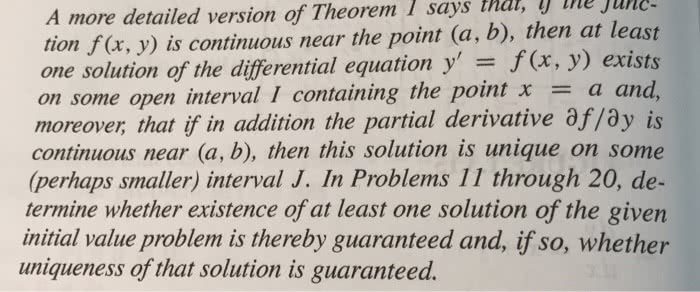MATH 246 Lecture Notes - Lecture 8: Linear Map, Linear Differential Equation, System Of Linear Equations
Document Summary
Math246 lecture 8 high order linear differential equation and homogeneous equation. Normal form (cid:1856)(cid:3041)(cid:1856)(cid:1872)(cid:3041)+ (cid:1853)(cid:4666)(cid:1872)(cid:4667)(cid:1856)(cid:3041) (cid:2869)(cid:1856)(cid:1872) + + (cid:1853)(cid:3041) (cid:2869)(cid:4666)(cid:1872)(cid:4667)(cid:1856)(cid:1856)(cid:1872) + (cid:1853)(cid:3041)(cid:4666)(cid:1872)(cid:4667)=(cid:1858)(cid:4666)(cid:1872)(cid:4667) (cid:1853)(cid:4666)(cid:1872)(cid:4667) . ,(cid:1853)(cid:3041)(cid:4666)(cid:1872)(cid:4667)= (cid:1855)(cid:1867)(cid:1857)(cid:1858)(cid:1858)(cid:1855)(cid:1857)(cid:1866)(cid:1872) f(t) = forcing term if f= 0, then, the equation is homogeneous, otherwise non-homogeneous. Initial value problem ( not the case for non linear ) A differential equation of order n with the initial condition. (cid:4666)(cid:1872)(cid:4667)= (cid:2868) (cid:4666)(cid:1872)(cid:4667)= (cid:2869) (cid:4666)(cid:3041) (cid:2869)(cid:4667)(cid:4666)(cid:1872)(cid:4667)= (cid:3041) (cid:2869) it can go on until. If a, (cid:1853)(cid:3041), f are continuous on ((cid:1872),(cid:1872)(cid:4667) , (cid:1872) (cid:1866) (cid:4666)(cid:1872),(cid:1872)(cid:4667),(cid:3042), . (cid:3041) (cid:2869) given in , then the initial value problem has a unique solution on ((cid:1872),(cid:1872)(cid:4667). The next portion of the notes obtained from professor wyss-gallifent, who is a collegue of. Note : these are all in linear normal form : The equations are often accompanied with boundary conditions. However, it does not always give a unique solution. Remark : the theorem identifies the interval of definition of the solution.



